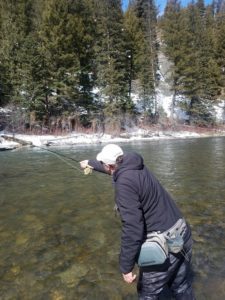By Patrick Straub EBS Fishing Columnist
There’s a rock on the Gallatin River not far from my fly shop that we call “Brad Pitt Rock.” Upon that rock, more than 30 years ago, the actor stood, casting a fly line high into the air. Robert Redford’s dreamy voice provided narration, “He called it shadow casting … ”
As a lifetime guide whose tenure began shortly after Redford’s film, “A River Runs Through It,” hit theatres, many of my fishing clients asked me to teach them how to shadow cast. My response is pretty candid: “Sure, I can teach you how to shadow cast, but I’d rather teach you how to cast so you can actually catch fish.”
The fly cast, by nature, is a blessing and a curse—an enjoyable and artistic activity in its own right, yet the utilitarian aspect of the fly cast should overrule aesthetics if your goal is to catch fish over catching a Hollywood director’s eye. Here’s some advice on fly fishing’s blue-collar casts.

 The roll cast. This is an essential cast to learn for many applications. It’s performed by slowly bringing the rod grip to slightly above and away from your ear, so the rod tip is pointed straight above your head or angled slightly back toward the sky behind your head. The fly line arcs in front of you with the bulk of the fly line still on the water. The rod is then accelerated quickly to a stop in front of you—at the same point the stop would occur on a normal forward cast.
The roll cast. This is an essential cast to learn for many applications. It’s performed by slowly bringing the rod grip to slightly above and away from your ear, so the rod tip is pointed straight above your head or angled slightly back toward the sky behind your head. The fly line arcs in front of you with the bulk of the fly line still on the water. The rod is then accelerated quickly to a stop in front of you—at the same point the stop would occur on a normal forward cast.
The roll cast is useful when obstructions occur behind you, making a normal back cast problematic. It’s also helpful when an abundance of slack line has piled up at your feet. By using a roll cast you can uncoil the slack and cast it in front of you, then go into a normal back cast once the roll cast is performed.
Lastly, a roll cast is used to unsnag a foul-hooked fly from an obstruction in front of you—this is called an unsnagging roll cast. It is performed by an aggressive roll cast in the direction of the snag, ensuring you roll cast enough fly line past the snagged fly so the fly is dislodged.
Tension cast or water haul. Similar to a roll cast, this cast can be used if an obstruction is behind you. It’s also an ideal cast when using weighted nymph rigs with a strike indicator, or when fishing sink-tip or sinking lines and large streamers from a boat.
When wading, begin by allowing the current to carry the fly line downstream of your standing position. Once the line has straightened out below you, use the tension of the current on the fly line to help you reposition the line upstream of you. Raise your rod hand to about head height and turn your palm upward to the sky. Then accelerate the rod forward and stop it as if in a normal forward casting motion.
When you’re in a boat, the cast is performed in two parts—first, a “reverse” tension cast by starting with the fly line downstream and in front of you, then accelerating into a back casting motion, allowing the fly line and flies to land on the water behind you. Then, with a very short pause, go into a forward cast while the tension of the current behind you on the fly line and flies helps you reposition the forward cast.
Two “after the cast” casts. A reach cast is essential for obtaining a long, drag-free presentation of the fly. Perform a reach cast by an extended follow through, across your body, of your cast after a stop is made on the forward cast. This follow through allows for a mend to be placed in the fly line before it lands on the water.
A slack line/pile cast allows for a fly to softly land on the surface, while creating a cushion of slack fly line to immediately accomplish a natural drift. It’s performed by stopping the forward cast slightly higher than normal. While the fly line is dropping to the water’s surface, gently wave the rod up and down to feed out a few curls of slack fly line.
Fishing slack line near Brad Pitt Rock is essential. There’s a few nice fish that live in the run below the rock; however, in the 30-plus years I’ve been fishing that run, I’ve never tried shadow casting while standing on the rock—my tension cast has always proved successful. I’m no movie star, but maybe that’s because in my fishing I choose what works over what’s sexy.
Pat Straub is a 20-year veteran guide on Montana’s waters and has fished the world over. He is the co-founder of the Montana Fishing Guide School, and the author of six books, including “The Frugal Fly Fisher,” “Montana On The Fly,” and “Everything You Always Wanted to Know About Fly Fishing.” He and his wife own Gallatin River Guides in Big Sky.













